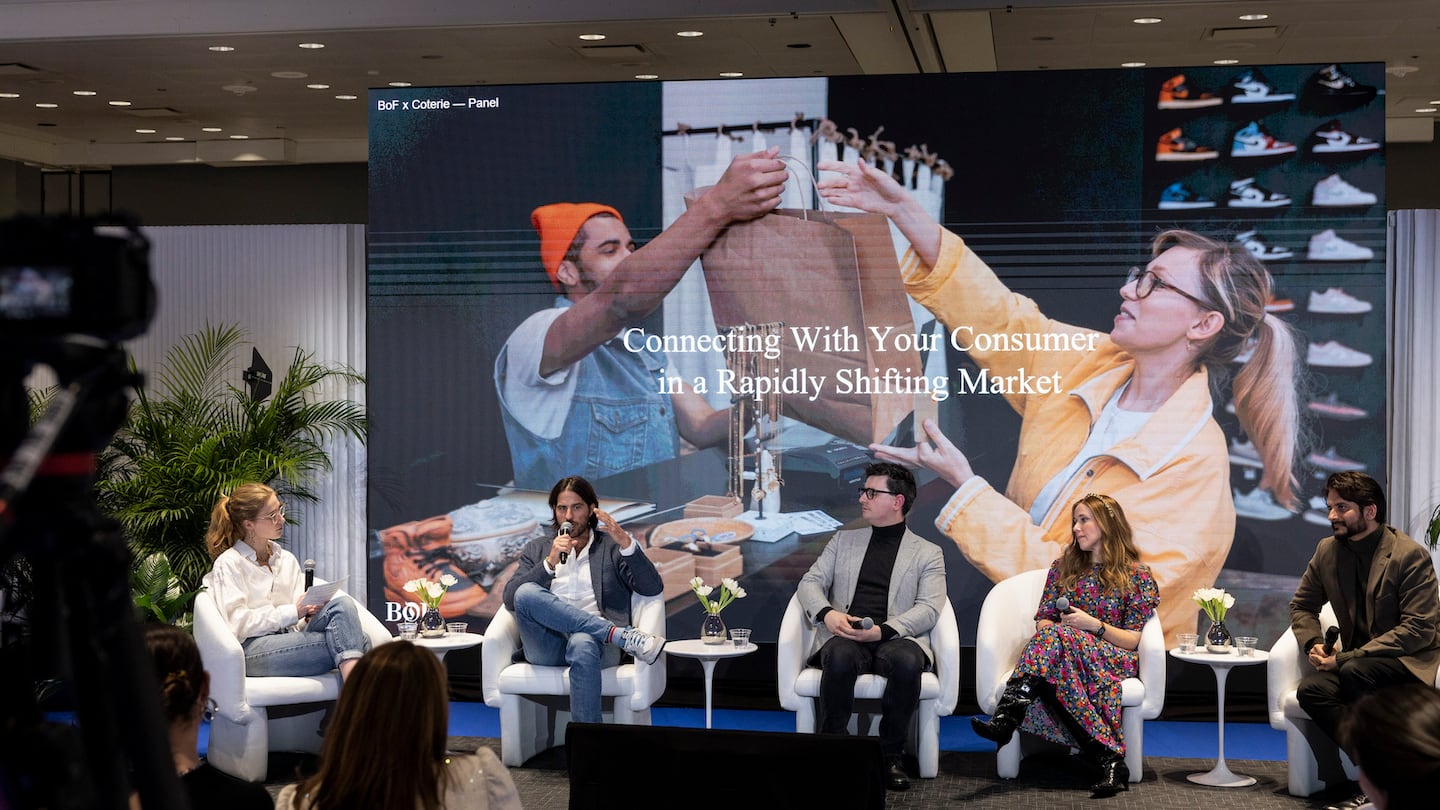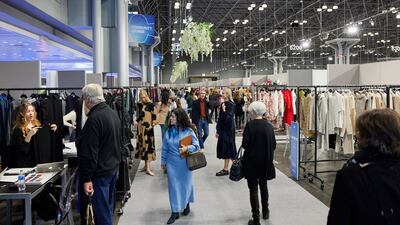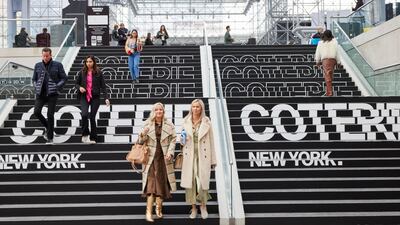
The Business of Fashion
Agenda-setting intelligence, analysis and advice for the global fashion community.

Agenda-setting intelligence, analysis and advice for the global fashion community.

Coterie New York is Informa Markets Fashion’s contemporary and advanced contemporary womenswear, accessories, footwear and beauty event, and has established itself as a key player in the market’s growth, helping launch, relaunch and scale brands from Helmut Lang to Alice and Olivia. This season, running from February 21-23, Coterie continued to evolve its focus on community, sustainability and technology, and welcomed nearly 900 showcasing brands with 30 percent of the show representing international countries.
Coterie also introduced new merchandised sections on the show floor that groups like-minded brands to make navigation seamless. A new segment, Gallery, was curated to highlight a portfolio of designers representing the new guard of sought-after designers with discerning perspectives, including the likes of Lelet NY, Simon Miller, Jason Wu Handbags, Honor the Gift and Jennifer Fisher Jewellery. Edit was a second space housing the women’s advanced contemporary fashion, showcasing international collections with a focus on quality, styling and fabrications. Exhibiting designers included Fedeli, Twinset Milano, European Culture and Meimeij.
Alongside its new merchandised sections, Coterie continues to build upon its role as a community connector and educator for fashion brands, buyers and retailers in New York and beyond. To meet industry needs and interests, the event offers a dedicated education programming, with the likes of eBay, Renewcell and Arcadia Group covering timely topics from Building a Sustainable Circular Economy in Fashion, to The Impact of Extended Reality (XR) and Digitisation. Supermodel Pat Cleveland also shared her story for the Coterie audience.

Within this educational offering, four showcasing brands at Coterie joined BoF on stage to discuss how brands across different categories are innovating how they connect with their consumers today. The panel included: Alex Faherty, co-founder and CEO of fashion and lifestyle brand Faherty; Jay Lakhani, co-founder and CEO of luxury accessories brand Deepa Gurnani; Martijn Swolfs, CEO of sustainable denim brand HNST; and Sara Sasson, founder, CEO and creative director of jewellery brand Lelet NY.
Below, BoF shares key takeaways from the talk — from digital methods and analogue techniques in-store and online, to how these brands are defining value today and expressing it to their consumers today.
Consumer surveys, whether sent post-purchase, to a mailing list or opened out to a wider community on social media channels, can offer valuable feedback on how to improve products and services. However, the critical learning is about acting on that feedback. If a consumer feels listened to, even involved in the product creation as Lelet NY offers, the brand can boost its retention and sustained engagement of the consumer.
SS: “Any time we get an email from a customer saying, ‘This doesn’t fit me right, or this is something that I would prefer,’ we [...] have a quick discussion and use that feedback, and that is something that has made us have really great customer retention.
“[Some consumers share feedback like] ‘I wish that this looked a little different and had a different colour’, and we will actually make [that] product and name it after the customer, and then that product will sell really well. [...] If you listen to your customers, you’re going to be able to grow.”
AF: “We do post-purchase surveys where we ask people, ‘How did you find out about the brand?’ And since we started [those surveys], about 25 percent of people say that their friends and family of Faherty. That’s too many people for us to actually be friends and family with, but [it’s] like a network effect.”
During Covid-19, cities experienced a mass exodus of residents and commuters as the pandemic popularised remote living and working — Reuters reported a net 70,000 people left New York in 2020, resulting in roughly $34 billion in lost income, while an Arup survey found 41 percent of Londoners moved out of the city at some point in the pandemic.
The relocation of residents to more rural, suburban areas, has subsequently placed a greater emphasis on local neighbourhoods — and fostering that sense of community in stores can impact audiences in a more nuanced, meaningful way.
AF: “People are living in a more local way these days. A lot of people moved out of the cities and to the suburbs, to neighbourhoods like Brooklyn versus living in Soho. So, I think people now want to experience those communities and not really go anywhere else. So, how can we do that, as a retailer? We can be a place where people like to spend time, whether that’s if they need to pick up a pair of pants or [...] one of our stores has [a coffee shop, for] example. Then, every month, we do different events in our stores to bring the community together.”
Every year, we probably spend a third of our time on the road, travelling to stores, to different markets. It’s just a great way to connect [with our consumers] locally.”
“I think musicians and bands do it the best [in] how they spread their name within parts of the country. [It’s about] how we go into new markets, meet customers where they are and get people to know the vibe of the brand. [...] Every year, we probably spend a third of our time on the road, travelling to stores, to different markets. [...] It’s just a great way to connect [with our consumers] locally.”
JL: “[Coterie] is a community of such amazing brands [and] when it comes to our vendor community, our voices are being heard. They’re listening to what we want, finding buyers, bringing them here. [...] This is the hub of passion and we’re all here for a specific reason to build that community and take it forward.”
Transparency is critical to a more sustainable future in fashion, driven by consumer concerns about issues including fair labour, sustainable resourcing and the environment. According to the 2021 Porter Novelli Purpose Premium Index (PPI), 73 percent of consumers say that to win their support, companies must show how they are supporting communities and the environment.
To foster an authentic connection between your customer and your brand, and to generate consumer trust, consumers today expect progress, not perfection. Being transparent offers insights into where a brand is in their journey to more ethical and sustainable business practices.

MS: “We have a big reach to people that are conscious about sustainability and circularity, and [...] they reach us on Instagram, on Facebook, and [...] ask [us] critical questions about how we produce the materials that we use, about the whole production process. We have to be able to answer their questions, so everything that we do is full transparency. We apply a ‘nothing to hide’ ethos — we are fully transparent on how [and] where we produce.”
JL: “We are being videotaped and watched every second of our day right now. So, if I’m saying something that’s not clear [for example,] I will get busted, no matter what. That’s just the way it is. If you’re true to yourself, if you stick to your career ethos or brand vision, your identity, [...] don’t lie. Just be honest, be transparent. In India [where Deepa Gurnani employs 300 artisans], we don’t have roads, we don’t have sidewalks, we don’t have water. We cannot be 100 percent sustainable. That’s just the way the infrastructure is in our country.
“Obviously, we’re going to make mistakes. Every day is a learning process. [...] You have to be honest and you have to provide customer service, honest feedback, and [the] opportunity for everyone to thrive. That’s the only way that’s going to be true — [through] honesty and transparency.”
It has become increasingly expensive to connect with consumers on social channels today. Advertisers spent about $29 to acquire each customer in 2022, compared with just $9 in 2013. Customer acquisition costs have risen on average 70 percent on TikTok and 39 percent on Meta platforms, including Instagram.
Brands can consider using newer platforms like Be Real or Discord, with growing and highly engaged communities, to connect with consumers by authentically reflecting the purpose of those platforms. Alternatively, using new products on existing social channels — like Instagram polls or new TikTok trends — can keep your community engagement timely and relevant.
MS: “Today, we mainly use platforms like Instagram and Facebook, but we are experimenting now [with] integrating, for example, BeReal, which is a platform that is based on the moment and focused on authenticity.
“We are trying to find a way on how we can integrate into our communication strategy platforms like Discord, for example, where you can really interact with your audience, and your audience can also interact with you. We believe this is meaningful and where you can really learn from your community, but also where they feel that they can also contribute something towards the brand.
We are trying to find a way to integrate into our communication strategy platforms like Discord, where you can really interact with your audience, and your audience can interact with you.
SS: “[Instagram] is really where our customers are hanging out and spending the most time, and the thing they like the most is when we ask them questions. We take polls and will ask them what they want to see next. Then, we ask them ‘What are your pain points? What are the things that you’re really loving right now?’ And we actually have a folder of all of their responses and we sort through those any time we’re creating a new collection. Each time we’re revisiting the style, their comments and feedback inform our pathway forward.”
AF: “I still respond to LinkedIn or Instagram messages that people send me. [As co-founders,] we’re still involved in customer service and any issues that happen in stores. I think it’s like keeping that connection where the customer feels they are actually working with a small family brand, which is what we are, and they know the owners and there’s something honest about that.”
“Anti-tech is also getting cooler. We [have created] a catalogue [since] 2015 which, over the last couple years, we’ve moved into more of a travel guide. So, our catalogues are more locations, we recommend trips we go on and help our community, educating them on cool stuff. [For example,] we just did a whole story about Peru.”
This is a sponsored feature paid for by Coterie as part of a BoF partnership.
As the German sportswear giant taps surging demand for its Samba and Gazelle sneakers, it’s also taking steps to spread its bets ahead of peak interest.
A profitable, multi-trillion dollar fashion industry populated with brands that generate minimal economic and environmental waste is within our reach, argues Lawrence Lenihan.
RFID technology has made self-checkout far more efficient than traditional scanning kiosks at retailers like Zara and Uniqlo, but the industry at large hesitates to fully embrace the innovation over concerns of theft and customer engagement.
The company has continued to struggle with growing “at scale” and issued a warning in February that revenue may not start increasing again until the fourth quarter.